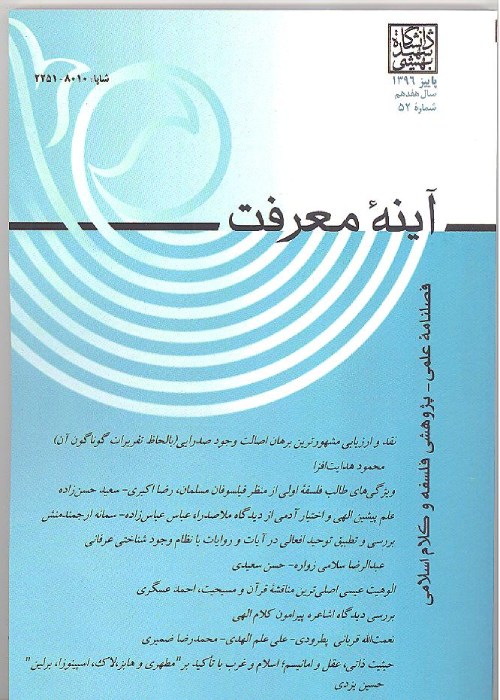Avicenna’s and Abolbarakate-Baghdadi’s Views on Spatial Movement
Author(s):
Article Type:
Research/Original Article (دارای رتبه معتبر)
Abstract:
According to Avicenna and Abolbarakate-Baghdadi, spatial movement is the oldest variety of movements. Avicenna sees spatial movement as the one which exclusively moves on a straight line so he does not consider circular movement as a type of spatial movement. His reason is that in circular movement the moving object’s components change their position in relation to the components of space but the moving object remains in its space altogether. Baghdadi considers both types of movement as spatial ones. Avicenna divides spatial movement to impulsive (QATIEH) and impetus-based (TAVASOTIEH) and postulates one as subjective and the other as objective. Baghdadi does not make such a distinction and probably attributes a sort of existence to spatial movement which he considers as causal through which a cause reaches its effect. Avicenna considers the driving force as different from the moving object. Although Baghdadi puts emphasis on this distinction, he attributes the duration of the movement to the moving object.
In relation to vertical movement, Avicenna believes in immobility between the upward and downward movement while Baghdadi considers both the same.
In relation to vertical movement, Avicenna believes in immobility between the upward and downward movement while Baghdadi considers both the same.
Keywords:
Language:
Persian
Published:
Ayeneh Marefat, Volume:14 Issue: 41, 2015
Page:
33
magiran.com/p1580112
دانلود و مطالعه متن این مقاله با یکی از روشهای زیر امکان پذیر است:
اشتراک شخصی
با عضویت و پرداخت آنلاین حق اشتراک یکساله به مبلغ 1,390,000ريال میتوانید 70 عنوان مطلب دانلود کنید!
اشتراک سازمانی
به کتابخانه دانشگاه یا محل کار خود پیشنهاد کنید تا اشتراک سازمانی این پایگاه را برای دسترسی نامحدود همه کاربران به متن مطالب تهیه نمایند!
توجه!
- حق عضویت دریافتی صرف حمایت از نشریات عضو و نگهداری، تکمیل و توسعه مگیران میشود.
- پرداخت حق اشتراک و دانلود مقالات اجازه بازنشر آن در سایر رسانههای چاپی و دیجیتال را به کاربر نمیدهد.
In order to view content subscription is required
Personal subscription
Subscribe magiran.com for 70 € euros via PayPal and download 70 articles during a year.
Organization subscription
Please contact us to subscribe your university or library for unlimited access!


